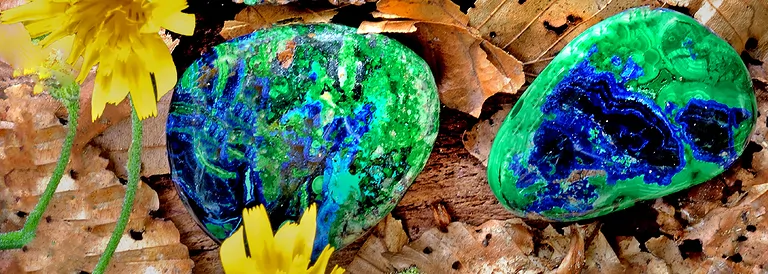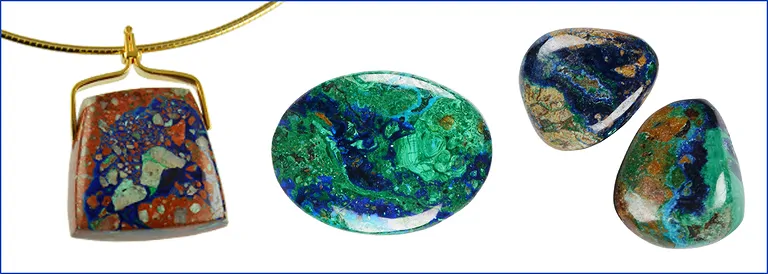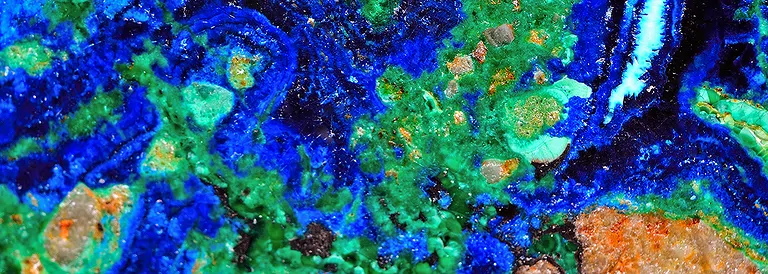
Azurite Malachite - Meaning, effect and application
Azurite-Malachite promotes interest in our surroundings and our fellow human beings, the stone makes us open-minded and helpful. With its help we can learn to listen to our feelings and emotions and to communicate them outwardly - inner tensions are thus overcome and dissolved, the space for a positive attitude towards life is there! Mind and emotions can be brought by the Azurite Malachite in a harmonious harmony.
Mineralogical profile of Azurite-Malachite
Chemical Formula: Cu3[(OH)2/(CO3)2] + Cu2[(OH)2/CO3] + H2O
Mineral Class: Carbonate
Evolution: formed as a secondary formation in the weathering zone of copper-bearing ore deposits or by the intrusion of late magmatic copper-rich solutions into carbonate-rich rocks.
Color: blue-green marbled, banded or filigree intergrown
Gloss: vitreous luster to silky luster.
Crystal system: monoclinic
Mohs hardness: 3.5 to 4
Splitability: imperfect splitability, earthy fracture
Occurrence, main supplying countries: The USA (California, Arizona) and Morocco have been known for a long time as supplying countries; beautiful azurite malachite has also been coming from Peru for some time now
Appearance: mixture of two copper minerals as fissure fillings of rock breccias and in the form of dense, bulbous or earthy masses.
Rough stones, spheres, donuts and more azurite malachite articles at wholesale prices
Origin of the name Azurite Malachite and synonyms
Azurite Malachite is the natural intergrowth of bright blue Azurite and green Malachite. His name received Azurite 1824 by the French mineralogist Francois Beudant in reference to the color "Azur". The Latin word "azzurum" for blue is derived from Persian ("lazaward", i.e. "sky blue") - also the French Mediterranean region Cote d'Azur has received its name from this term.
The origin of the name "malachite" is not clear: Probably it derives from the Greek word "malache" or "moloche" for "mallow" whose dark green leaves the equally dark green Malachite reminds. This would explain also the historical name "Malvenstein". Other synonyms under which the Azurite Malachite is sold in retail as well as wholesale are Azurite Malachite and Royal Gem Azurite.

Application of azurite-malachite in gemstone healing
Azurite malachite is the gemstone of connection and harmonization: mind and feeling, head and heart can be brought into harmony with its support. Inner conflicts can be resolved, you become open-minded (again) and interested in your fellow human beings. The expression of feelings is supported, negative things can be overcome more quickly and easily.
In modern gemstone healing, wearing azurite-malachite as a piece of jewelry, e.g. as a bracelet or drilled gemstone, has proven effective. Direct contact between the stone and the body is an advantage here. The intensive observation of azurite malachite, e.g. as a sphere, point or cut, is also used in gemstone healing.
Like all copper minerals, azurite malachite as a water stone is not suitable for direct immersion in water. However, the test tube method and infusion via a crystal are well suited for the production of gemstone water.
Azurite malachite articles at wholesale prices for mineral shops and comerial customers
Stabilization of azurite-malachite
Azurite Malachite is not initially suitable as a gemstone, for example, for cutting donuts or tumbling baroque stones, due to its porosity and good cleavage. However, if the rough stones are briefly soaked in synthetic resin before processing, the stone is stabilized and can then be cut or tumbled.
From the grinding residues of Azurite and Malachite are also pressed with the addition of plastic blocks, from which then again gemstone articles are cut. This process is called "recontruction". Since 1991, there is also an Azurite Malachite imitation of colored and under high pressure with plastic compressed barite powder in circulation.
The rough stones from which our Azurite Malachite articles have been made, we have purchased directly from the mines in the USA.With many articles is therefore also still a certain amount of brown from the surrounding matrix contained, Before processing, the raw stones are stabilized; this is marked with the article with the addition "(stab.)".

Blue-green sky - azurite and malachite as color pigments
Over 3000 years ago, the ancient Egyptians already used ground Azurite as color pigments for their paintings and, mixed with egg white, to make up the eyes. The use of azurite also has a long tradition in many other regions of the world, for example, among the indigenous people in the southwest of the present-day USA and in the Chinese Ming Dynasty (1368 - 1644). In Europe, the mineral was used by Albrecht Dürer and other Renaissance painters. The blue Azurite was mostly used only as an undercoat - the much more expensive Lapis Lazuli was used as a topcoat. Through contact with oxygen in the air azurite is gradually transformed into the green mineral malachite - therefore the sky on older paintings sometimes has a distinct green tint. With the invention of "Prussian Blue" at the beginning of the 18th century, azurite then lost its importance as a pigment, but is still used today in the restoration of old paintings.
A close relative of azurite is the bright green malachite. Depending on the CO2 content of the solution from which the minerals are formed, malachite or azurite is formed. If the CO2 content changes at a later time, azurite transforms into malachite, but retains its typical crystal form. This process is called "pseudomorphosis" by mineralogists.